sensor RENAULT SCENIC 2009 J84 / 2.G Engine And Peripherals EDC16 Workshop Manual
[x] Cancel search | Manufacturer: RENAULT, Model Year: 2009, Model line: SCENIC, Model: RENAULT SCENIC 2009 J84 / 2.GPages: 273
Page 225 of 273
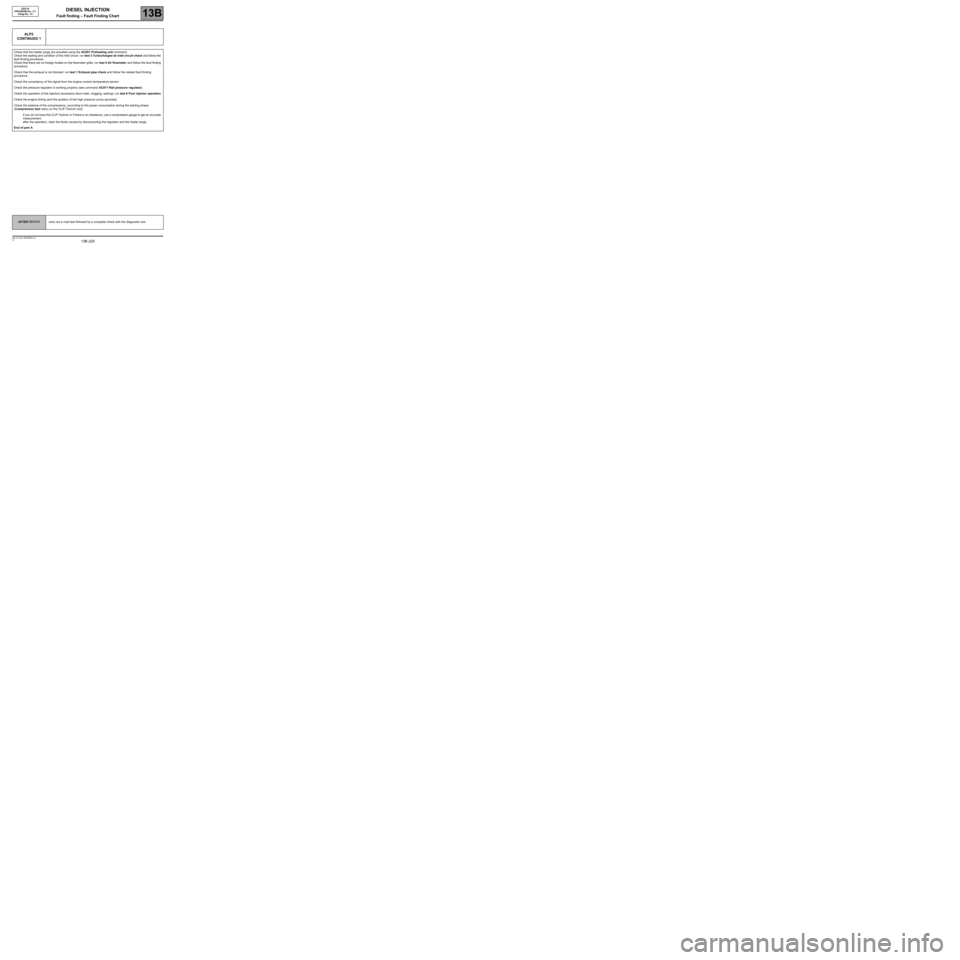
DIESEL INJECTION
Fault finding – Fault Finding Chart13B
13B -225V3 MR-372-J84-13B250$855.mif
EDC16
PROGRAM No.: C1
Vdiag No.: 51
ALP2
CONTINUED 1
Check that the heater plugs are actuated using the AC001 Preheating unit command.
Check the sealing and condition of the inlet circuit: run test 3 Turbocharged air inlet circuit check and follow the
fault finding procedure.
Check that there are no foreign bodies on the flowmeter grille: run test 4 Air flowmeter and follow the fault finding
procedure.
Check that the exhaust is not blocked: run test 1 Exhaust pipe check and follow the related fault finding
procedure.
Check the consistency of the signal from the engine coolant temperature sensor.
Check the pressure regulator is working properly (see command AC011 Rail pressure regulator).
Check the operation of the injectors (excessive return leak, clogging, seizing): run test 8 Poor injector operation.
Check the engine timing (and the position of the high pressure pump sprocket).
Check the balance of the compressions, according to the power consumption during the starting phase
(Compression test menu on the CLIP Technic tool).
If you do not have the CLIP Technic or if there is an imbalance, use a compression gauge to get an accurate
measurement.
after the operation, clear the faults caused by disconnecting the regulator and the heater plugs.
End of part A
AFTER REPAIRcarry out a road test followed by a complete check with the diagnostic tool.
Page 229 of 273
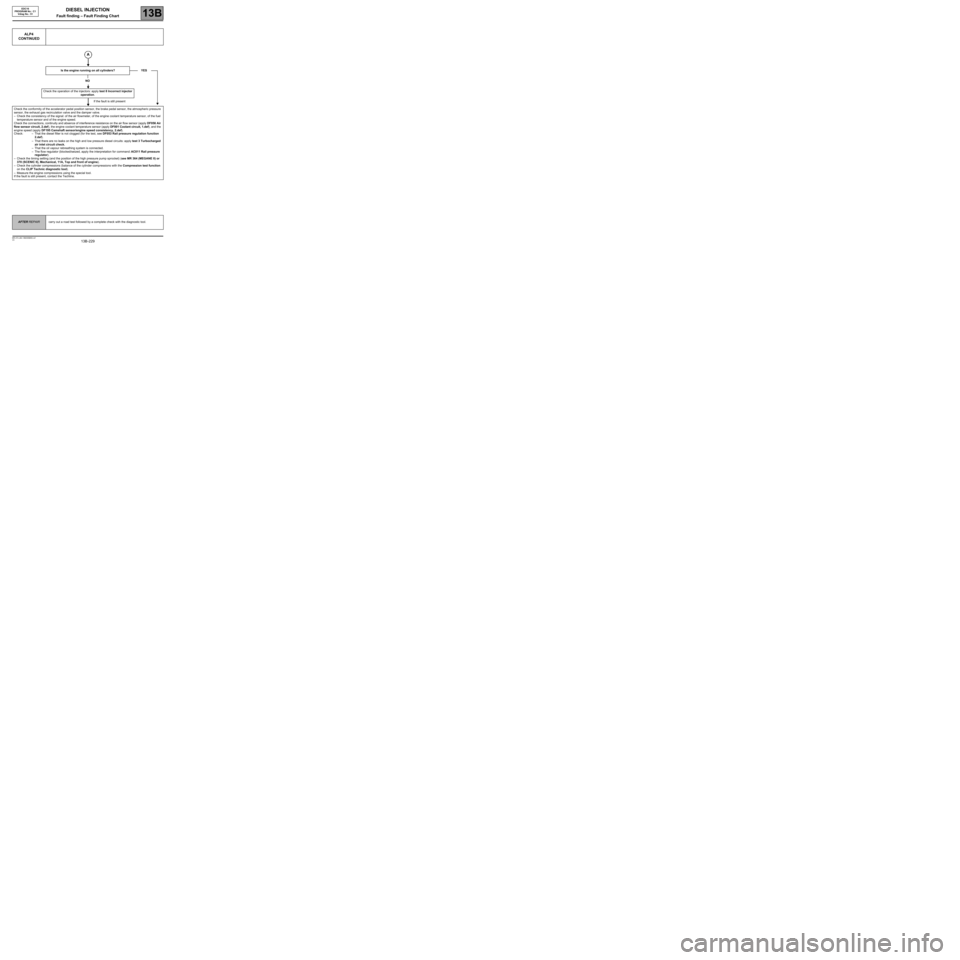
DIESEL INJECTION
Fault finding – Fault Finding Chart13B
13B -229V3 MR-372-J84-13B250$855.mif
ALP4
CONTINUED
Is the engine running on all cylinders?
NO
Check the operation of the injectors: apply test 8 Incorrect injector
operation.
If the fault is still present
Check the conformity of the accelerator pedal position sensor, the brake pedal sensor, the atmospheric pressure
sensor, the exhaust gas recirculation valve and the damper valve.
–Check the consistency of the signal: of the air flowmeter, of the engine coolant temperature sensor, of the fuel
temperature sensor and of the engine speed.
Check the connections, continuity and absence of interference resistance on the air flow sensor (apply DF056 Air
flow sensor circuit, 2.def), the engine coolant temperature sensor (apply DF001 Coolant circuit, 1.def), and the
engine speed (apply DF195 Camshaft sensor/engine speed consistency, 2.def).
Check: – That the diesel filter is not clogged (for the test, see DF053 Rail pressure regulation function
2.def).
–That there are no leaks on the high and low pressure diesel circuits: apply test 3 Turbocharged
air inlet circuit check.
–That the oil vapour rebreathing system is connected.
–The flow regulator (blocked/seized, apply the interpretation for command: AC011 Rail pressure
regulator).
–Check the timing setting (and the position of the high pressure pump sprocket) (see MR 364 (MEGANE II) or
370 (SCENIC II), Mechanical, 11A, Top and front of engine).
–Check the cylinder compressions (balance of the cylinder compressions with the Compression test function
on the CLIP Technic diagnostic tool).
–Measure the engine compressions using the special tool.
If the fault is still present, contact the Techline.YES
EDC16
PROGRAM No.: C1
Vdiag No.: 51
AFTER REPAIRcarry out a road test followed by a complete check with the diagnostic tool.
Page 230 of 273
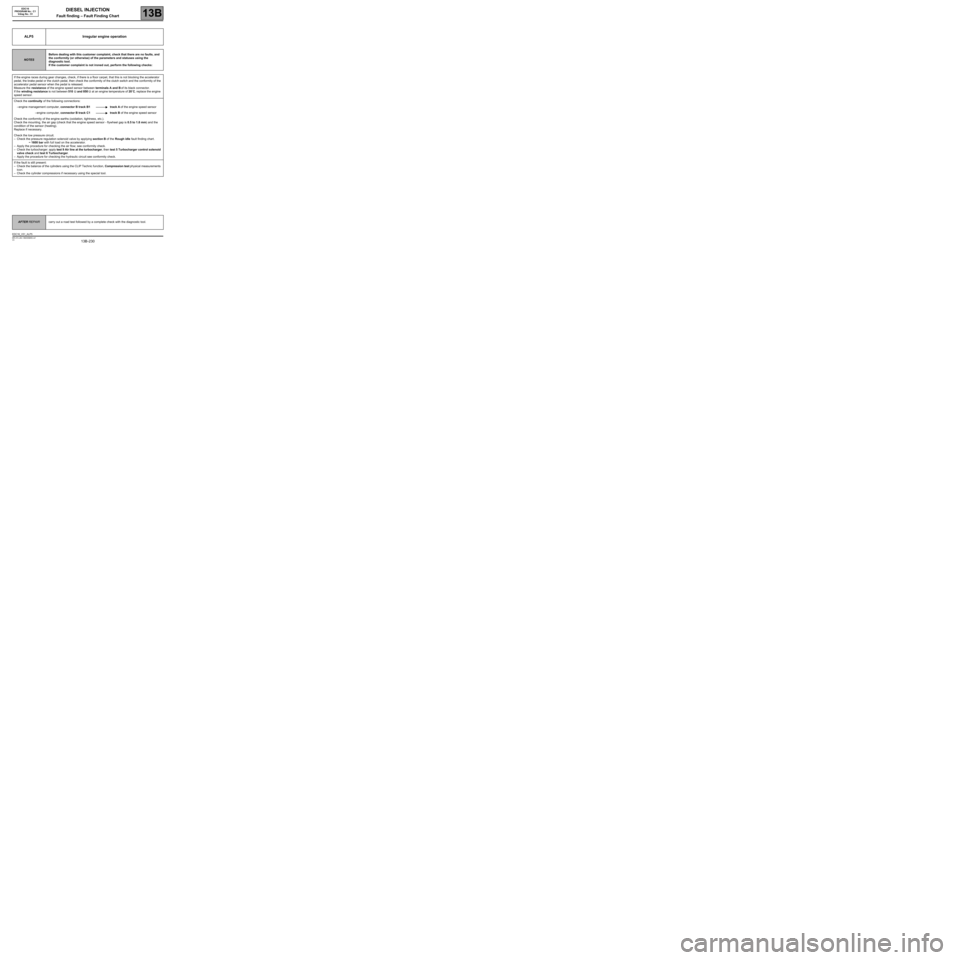
DIESEL INJECTION
Fault finding – Fault Finding Chart13B
13B -230V3 MR-372-J84-13B250$855.mif
EDC16
PROGRAM No.: C1
Vdiag No.: 51
ALP5 Irregular engine operation
NOTESBefore dealing with this customer complaint, check that there are no faults, and
the conformity (or otherwise) of the parameters and statuses using the
diagnostic tool.
If the customer complaint is not ironed out, perform the following checks:
If the engine races during gear changes, check, if there is a floor carpet, that this is not blocking the accelerator
pedal, the brake pedal or the clutch pedal, then check the conformity of the clutch switch and the conformity of the
accelerator pedal sensor when the pedal is released.
Measure the resistance of the engine speed sensor between terminals A and B of its black connector.
If the winding resistance is not between 510 Ω and 850 Ω at an engine temperature of 20˚C, replace the engine
speed sensor.
Check the continuity of the following connections:
–engine management computer, connector B track B1 track A of the engine speed sensor
–engine computer, connector B track C1 track B of the engine speed sensor
Check the conformity of the engine earths (oxidation, tightness, etc.).
Check the mounting, the air gap (check that the engine speed sensor - flywheel gap is 0.5 to 1.8 mm) and the
condition of the sensor (heating).
Replace if necessary.
Check the low pressure circuit.
–Check the pressure regulation solenoid valve by applying section B of the Rough idle fault finding chart.
~ 1600 bar with full load on the accelerator.
–Apply the procedure for checking the air flow; see conformity check.
–Check the turbocharger: apply test 9 Air line at the turbocharger, then test 5 Turbocharger control solenoid
valve check and test 6 Turbocharger.
–Apply the procedure for checking the hydraulic circuit see conformity check.
If the fault is still present:
–Check the balance of the cylinders using the CLIP Technic function, Compression test physical measurements
icon.
–Check the cylinder compressions if necessary using the special tool.
AFTER REPAIRcarry out a road test followed by a complete check with the diagnostic tool.
EDC16_V51_ALP5
Page 233 of 273
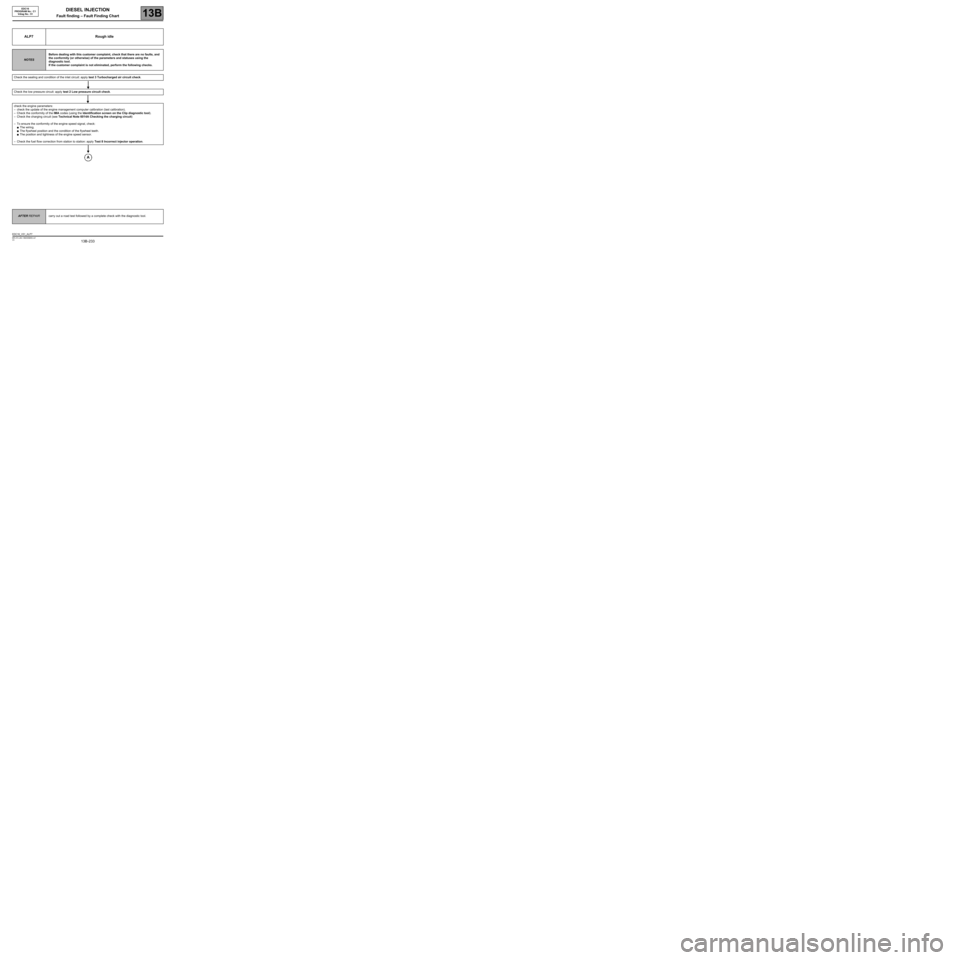
DIESEL INJECTION
Fault finding – Fault Finding Chart13B
13B -233V3 MR-372-J84-13B250$855.mif
EDC16
PROGRAM No.: C1
Vdiag No.: 51
ALP7 Rough idle
NOTESBefore dealing with this customer complaint, check that there are no faults, and
the conformity (or otherwise) of the parameters and statuses using the
diagnostic tool.
If the customer complaint is not eliminated, perform the following checks.
Check the sealing and condition of the inlet circuit: apply test 3 Turbocharged air circuit check.
Check the low pressure circuit: apply test 2 Low pressure circuit check.
check the engine parameters:
–check the update of the engine management computer calibration (last calibration).
–Check the conformity of the IMA codes (using the Identification screen on the Clip diagnostic tool).
–Check the charging circuit (see Technical Note 6014A Checking the charging circuit)
–To ensure the conformity of the engine speed signal, check:
●The wiring.
●The flywheel position and the condition of the flywheel teeth.
●The position and tightness of the engine speed sensor.
–Check the fuel flow correction from station to station: apply Test 8 Incorrect injector operation.
AFTER REPAIRcarry out a road test followed by a complete check with the diagnostic tool.
EDC16_V51_ALP7
Page 240 of 273
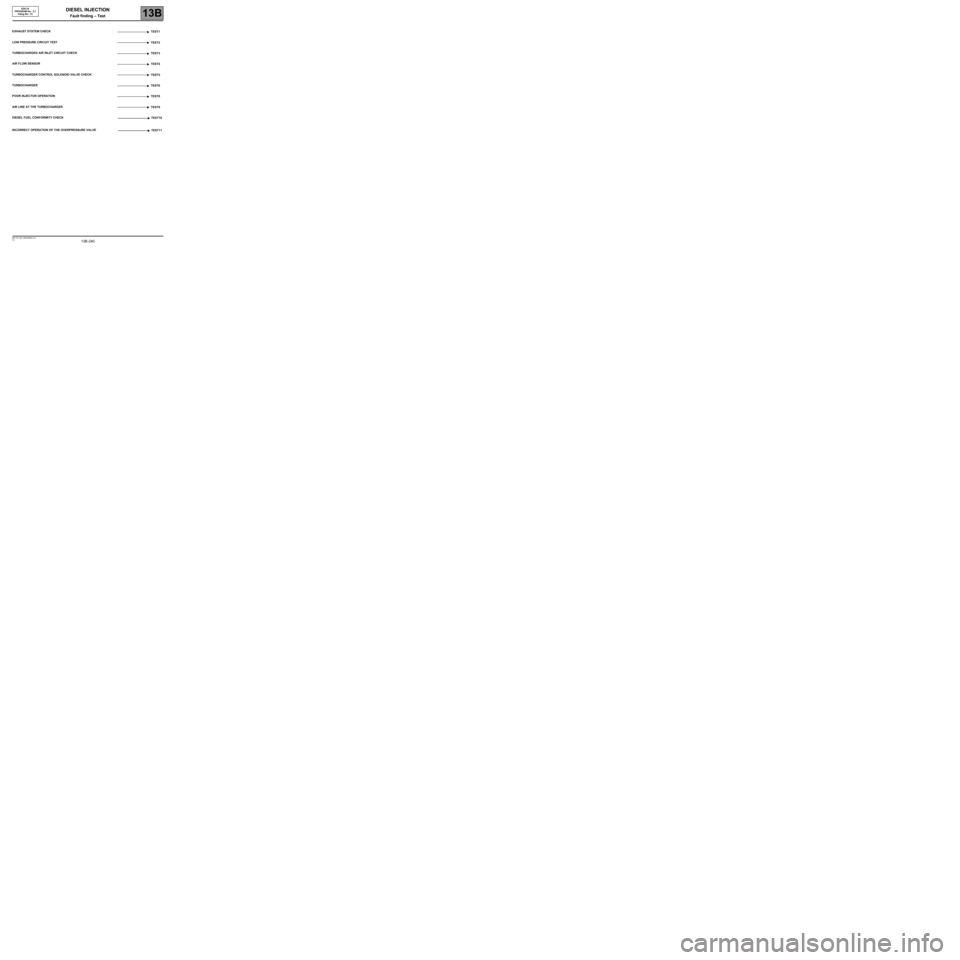
DIESEL INJECTION
Fault finding – Test13B
13B -240V3 MR-372-J84-13B250$900.mif
EDC16
PROGRAM No.: C1
Vdiag No.: 51DIESEL INJECTION
Fault finding – Test
EXHAUST SYSTEM CHECK
TEST1
LOW PRESSURE CIRCUIT TEST
TEST2
TURBOCHARGED AIR INLET CIRCUIT CHECK
TEST3
AIR FLOW SENSOR
TEST4
TURBOCHARGER CONTROL SOLENOID VALVE CHECK
TEST5
TURBOCHARGER
TEST6
POOR INJECTOR OPERATION
TEST8
AIR LINE AT THE TURBOCHARGER
TEST9
DIESEL FUEL CONFORMITY CHECK
TEST10
INCORRECT OPERATION OF THE OVERPRESSURE VALVE
TEST11
Page 245 of 273
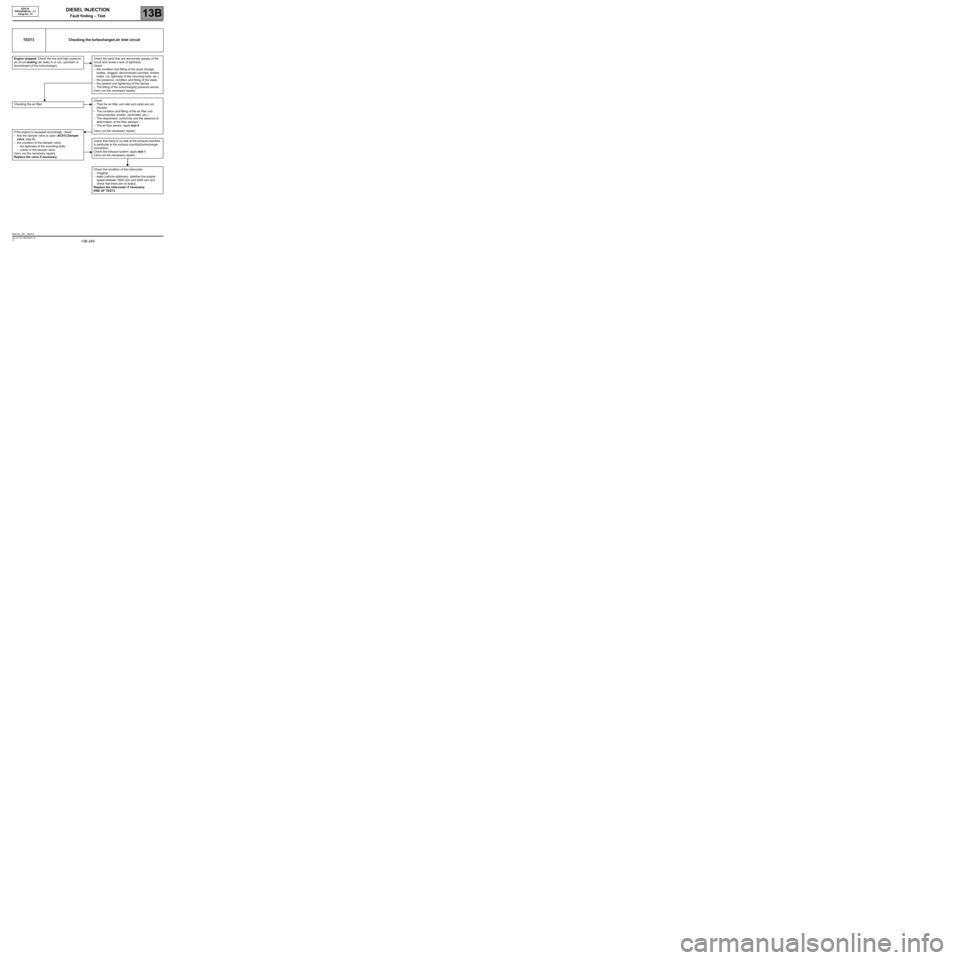
DIESEL INJECTION
Fault finding – Test13B
13B -245V3 MR-372-J84-13B250$900.mif
Checking the air filter.
If the engine is equipped accordingly, check:
–that the damper valve is open (AC012 Damper
valve, step B).
–the condition of the damper valve:
–the tightness of the mounting bolts,
–cracks in the damper valve.
Carry out the necessary repairs.
Replace the valve if necessary.
EDC16
PROGRAM No.: C1
Vdiag No.: 51
TEST3 Checking the turbocharged air inlet circuit
Engine stopped: Check the low and high pressure
air circuit sealing (air leaks in or out, upstream or
downstream of the turbocharger).Check the parts that are abnormally greasy of the
circuit and reveal a lack of tightness.
Check:
–the condition and fitting of the ducts (foreign
bodies, clogged, disconnected, pinched, broken,
holed, cut, tightness of the mounting bolts, etc.).
–the presence, condition and fitting of the seals.
–the present and tightening of the clamps.
–The fitting of the turbocharging pressure sensor.
Carry out the necessary repairs.
Check:
–That the air filter unit inlet and outlet are not
blocked.
–The condition and fitting of the air filter unit
(disconnected, broken, perforated, etc.).
–The cleanliness, conformity and the absence of
deformation of the filter element.
–The air flow sensor: apply test 4.
Carry out the necessary repairs.
Check that there is no leak at the exhaust manifold,
in particular at the exhaust manifold/turbocharger
connection.
Check the exhaust system: apply test 1.
Carry out the necessary repairs.
Check the condition of the intercooler:
–clogging,
–leaks (vehicle stationary, stabilise the engine
speed between 3500 rpm and 4000 rpm and
check that there are no leaks).
Replace the intercooler if necessary.
END OF TEST3.
EDC16_V51_TEST3
Page 246 of 273
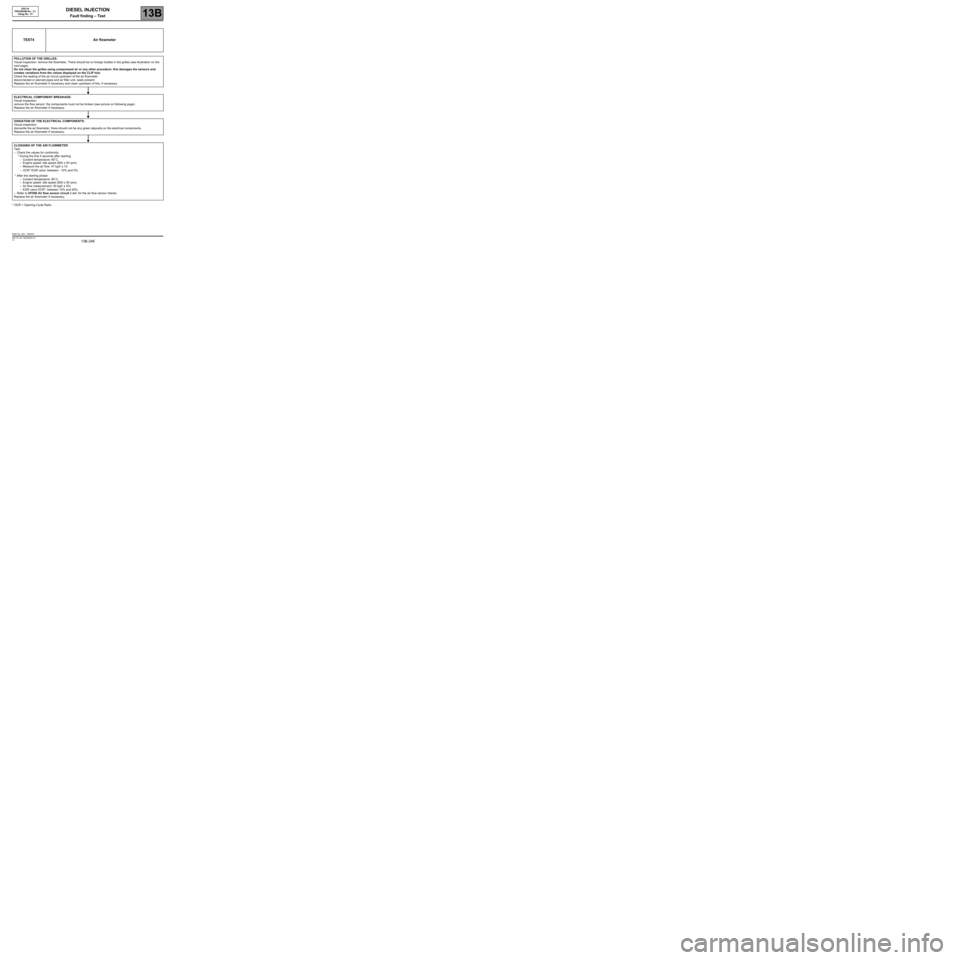
DIESEL INJECTION
Fault finding – Test13B
13B -246V3 MR-372-J84-13B250$900.mif
EDC16
PROGRAM No.: C1
Vdiag No.: 51
* OCR = Opening Cycle Ratio.
TEST4 Air flowmeter
POLLUTION OF THE GRILLES:
Visual inspection: remove the flowmeter. There should be no foreign bodies in the grilles (see illustration on the
next page).
Do not clean the grilles using compressed air or any other procedure: this damages the sensors and
creates variations from the values displayed on the CLIP tool.
Check the sealing of the air circuit upstream of the air flowmeter:
disconnected or pierced pipes and air filter unit, seals present.
Replace the air flowmeter if necessary and clean upstream of this, if necessary.
ELECTRICAL COMPONENT BREAKAGE:
Visual inspection:
remove the flow sensor: the components must not be broken (see picture on following page).
Replace the air flowmeter if necessary.
OXIDATION OF THE ELECTRICAL COMPONENTS:
Visual inspection:
dismantle the air flowmeter, there should not be any green deposits on the electrical components.
Replace the air flowmeter if necessary.
CLOGGING OF THE AIR FLOWMETER:
Test:
–Check the values for conformity:
* During the first 5 seconds after starting:
–Coolant temperature: 80˚C,
–Engine speed: idle speed (800 ± 50 rpm);
–Measure the air flow: 47 kg/h ± 10.
–OCR* EGR valve: between - 10% and 0%.
* After the starting phase:
–Coolant temperature: 80˚C,
–Engine speed: idle speed (800 ± 50 rpm);
–Air flow measurement: 30 kg/h ± 5%;
–EGR valve OCR*: between 10% and 40%.
–Refer to DF056 Air flow sensor circuit 2.def, for the air flow sensor checks.
Replace the air flowmeter if necessary.
EDC16_V51_TEST4
Page 247 of 273
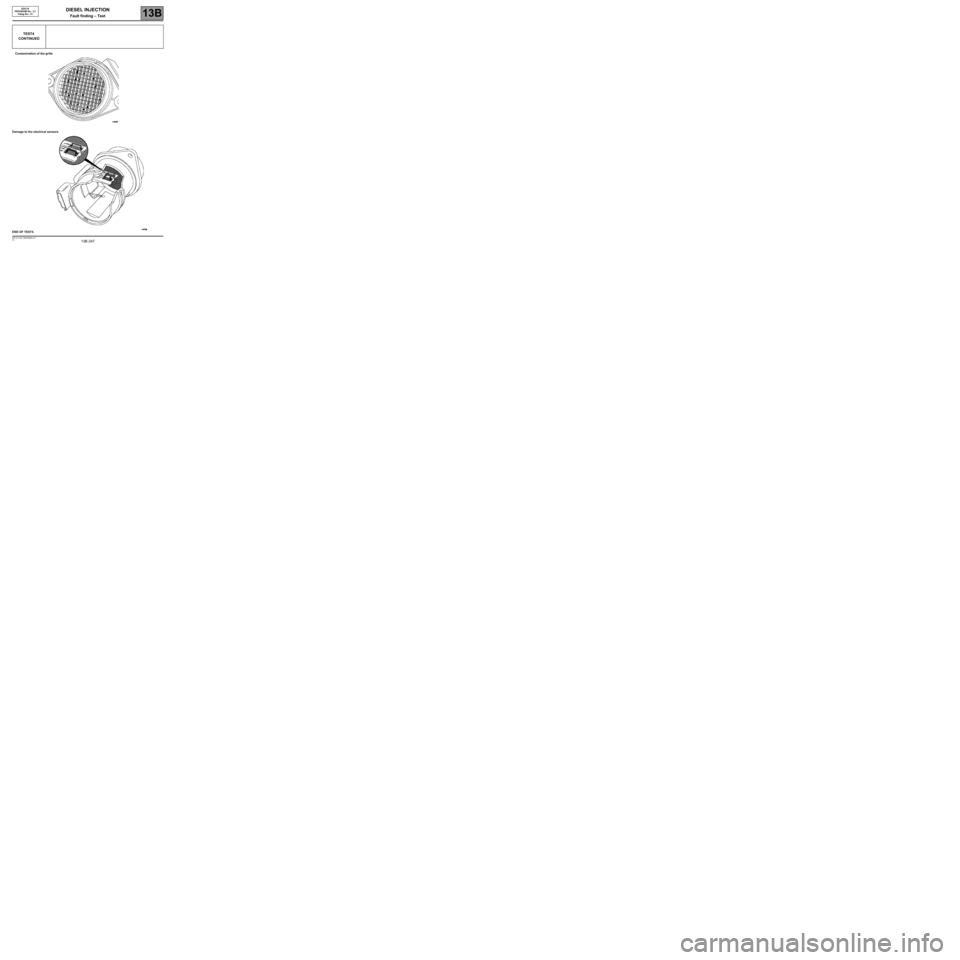
DIESEL INJECTION
Fault finding – Test13B
13B -247V3 MR-372-J84-13B250$900.mif
EDC16
PROGRAM No.: C1
Vdiag No.: 51
Contamination of the grille
Damage to the electrical sensors
TEST4
CONTINUED
END OF TEST4.
Page 265 of 273
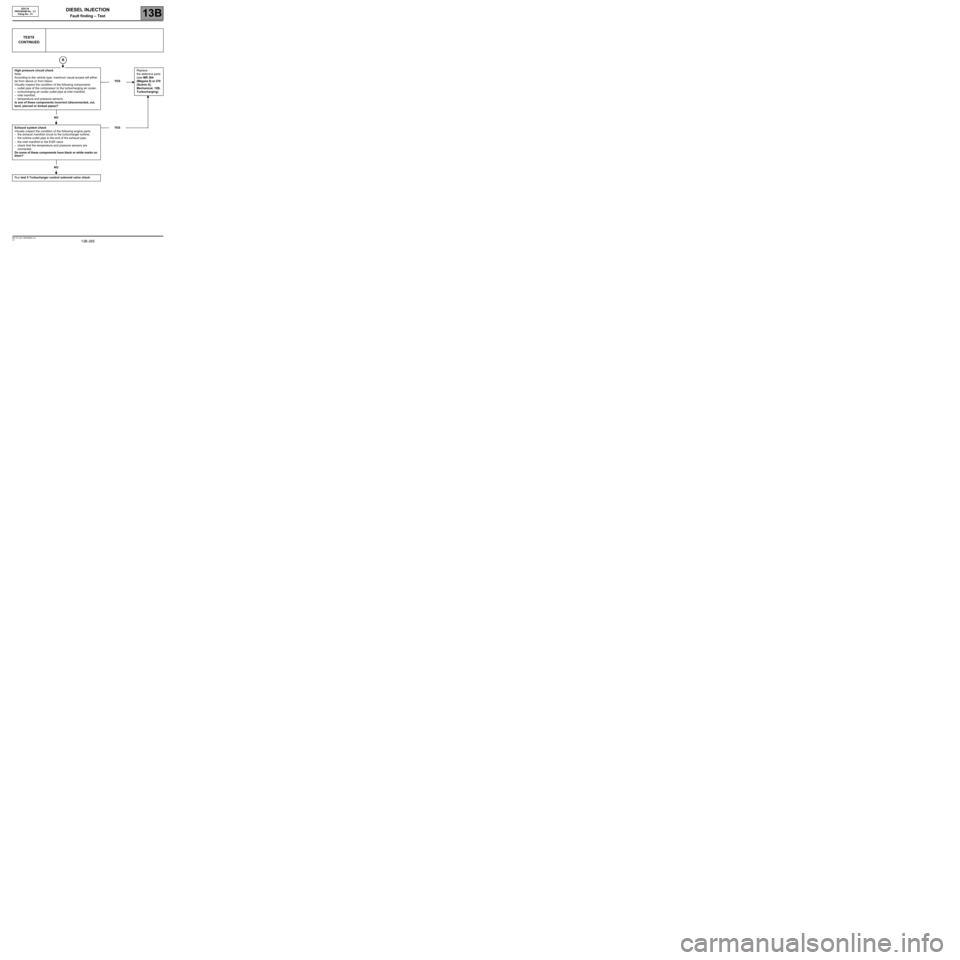
DIESEL INJECTION
Fault finding – Test13B
13B -265V3 MR-372-J84-13B250$900.mif
EDC16
PROGRAM No.: C1
Vdiag No.: 51
TEST9
CONTINUED
High pressure circuit check
Note:
According to the vehicle type, maximum visual access will either
be from above or from below.
Visually inspect the condition of the following components:
–outlet pipe of the compressor to the turbocharging air cooler,
–turbocharging air cooler outlet pipe at inlet manifold,
–inlet manifold,
–temperature and pressure sensors.
Is one of these components incorrect (disconnected, cut,
bent, pierced or kinked pipes)?YESReplace
the defective parts
(see MR 364
(Mégane II) or 370
(Scénic II),
Mechanical, 12B,
Turbocharging).
NO
Exhaust system check
Visually inspect the condition of the following engine parts:
–the exhaust manifold circuit to the turbocharger turbine,
–the turbine outlet pipe to the end of the exhaust pipe,
–the inlet manifold to the EGR valve
–check that the temperature and pressure sensors are
connected.
Do some of these components have black or white marks on
them? YES
NO
Run test 5 Turbocharger control solenoid valve check.
Page 273 of 273
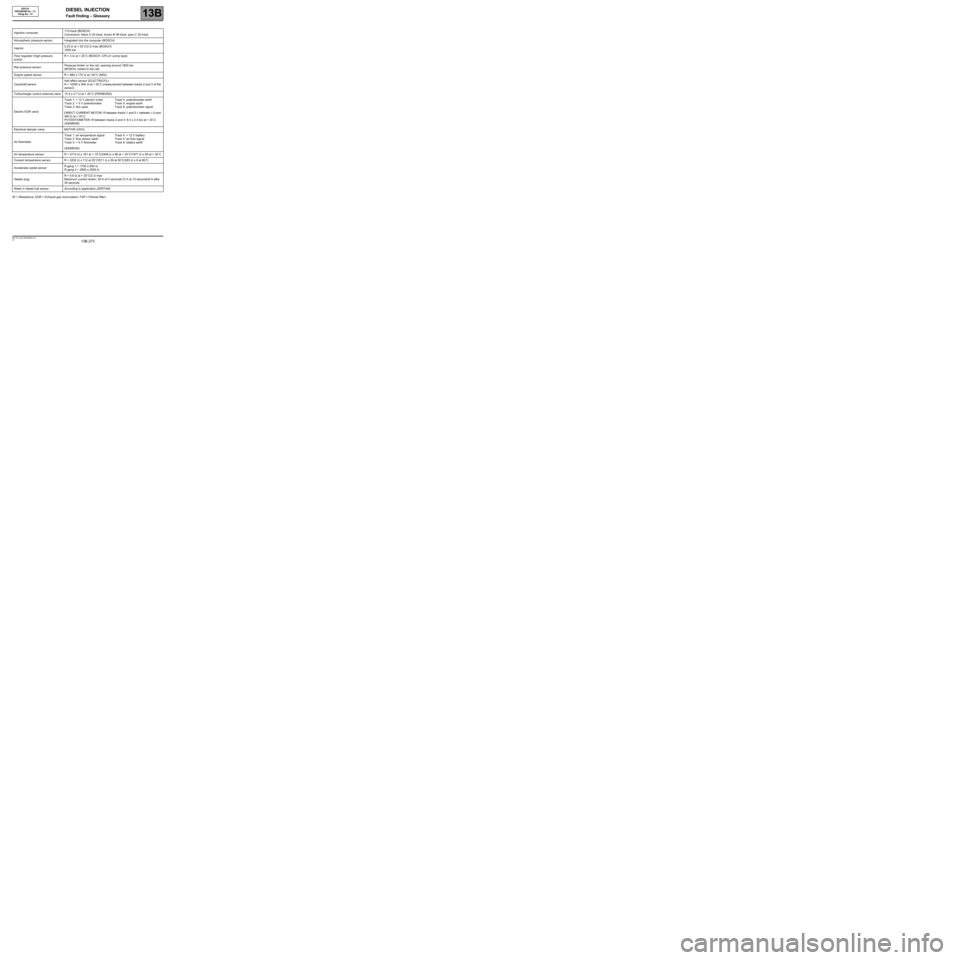
DIESEL INJECTION
Fault finding – Glossary13B
13B -273V3 MR-372-J84-13B250$945.mif
EDC16
PROGRAM No.: C1
Vdiag No.: 51DIESEL INJECTION
Fault finding – Glossary
(R = Resistance, EGR = Exhaust gas recirculation, FAP = Particle filter)Injection computer112-track (BOSCH)
Connectors: black A 32-track, brown B 48-track, grey C 32-track
Atmospheric pressure sensor Integrated into the computer (BOSCH)
Injector0.23 Ω at + 20˚C/2 Ω max (BOSCH)
1600 bar
Flow regulator (high pressure
pump)R = 3 Ω at + 20˚C (BOSCH, CP3.2+ pump type)
Rail pressure sensorPressure limiter on the rail: opening around 1800 bar
(BOSCH, bolted to the rail)
Engine speed sensor R = 680 ± 170 Ω at +20˚C (MGI)
Camshaft sensorHall effect sensor (ELECTRICFIL)
R = 10250 ± 500 Ω at + 20˚C (measurement between tracks 2 and 3 of the
sensor)
Turbocharger control solenoid valve 15.4 ± 0.7 Ω at + 20˚C (PIERBURG)
Electric EGR valveTrack 1: + 12 V electric motor
Track 2: + 5 V potentiometer
Track 3: Not usedTrack 4: potentiometer earth
Track 5: engine earth
Track 6: potentiometer signal
DIRECT CURRENT MOTOR: R between tracks 1 and 5 = between 1 Ω and
400 Ω at + 20˚C
POTENTIOMETER: R between tracks 2 and 4: 6.5 ± 2.4 kΩ at + 20˚C
(SIEMENS)
Electrical damper valve MOTOR (VDO)
Air flowmeterTrack 1: air temperature signal
Track 2: flow sensor earth
Track 3: + 5 V flowmeterTrack 4: + 12 V battery
Track 5: air flow signal
Track 6: battery earth
(SIEMENS)
Air temperature sensor R = 3714 Ω ± 161 at + 10˚C/2448 Ω ± 96 at + 20˚C/1671 Ω ± 59 at + 30˚C
Coolant temperature sensor R = 2252 Ω ± 112 at 25˚C/811 Ω ± 39 at 50˚C/283 Ω ± 8 at 80˚C
Accelerator pedal sensorR gang 1 = 1700 ± 900 Ω;
R gang 2 = 2850 ± 2050 Ω
Heater plugR = 0.6 Ω at + 20˚C/2 Ω max
Maximum current drawn: 28 A at 0 seconds/12 A at 10 seconds/9 A after
30 seconds
Water in diesel fuel sensor According to application (ZERTAN)